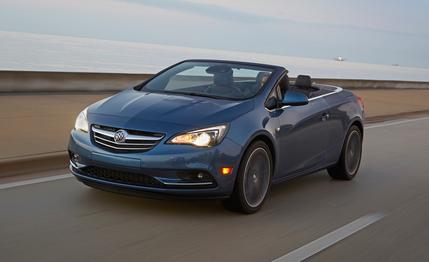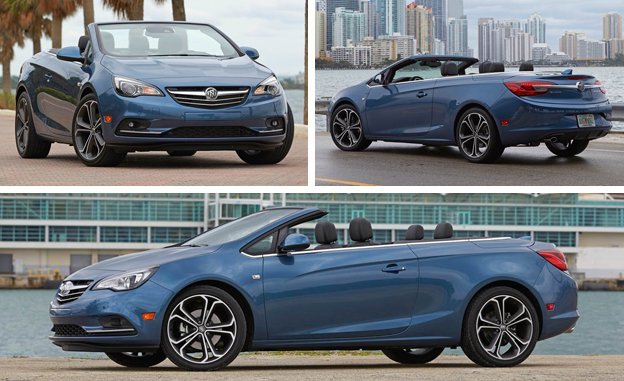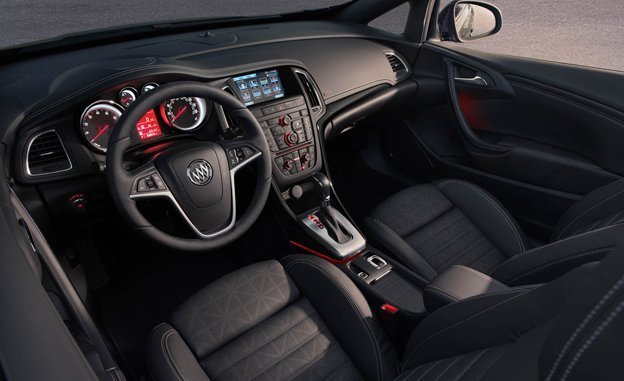
 First Drive Review
First Drive Review
We do not envy marketers. The majority of all products are, statistically speaking, mediocre. If everything was the best or the most or the otherwise hyperbolic, nobody would know what a bell curve was. But can you imagine a marketing campaign that crowed about a product’s unwavering mediocrity?
The Buick Cascada is another rare type of marketing campaign: The car as marketing. Sure, there will be advertisements for it, but the car itself is an advertisement for Buick. An inordinate number of the brand’s 223,055 U.S. sales last year were in the Midwest. Get too far outside of the home turf, and sales slow to a trickle. It won’t surprise you to know that none of the largest convertible markets in the U.S. are in the Midwest. So as much as the Cascada exists to bolster Buick’s sales numbers, the brand’s marketers don’t expect all of the additional sales to be Cascadas. They’re just as excited about the number of people they hope will come into the showroom to check out the convertible and then drive home in a new LaCrosse or an Enclave.


Buick’s commitment here is as small as the car’s sales potential: The Cascada is just an Opel with a different logo. Don’t feel cheated; Regal and Verano buyers don’t, and they’re more or less cruising around in Opel Insignias and Astras. The Cascada shares much of its structure with the Verano but has a longer wheelbase, strengthened A-pillars, substantial underbody bracing, and a fortified rear bulkhead. All that reinforcement adds up to a convertible that doesn’t so much tip the scales as it clanks it down, bends the beam, and flings two tons of counterweights about the garage. Four thousand pounds is some serious mass for a car this size. The Verano, at just an inch shorter and an inch narrower, is some 450 pounds lighter. The Cascada is nearly as heavy as the BMW M4 convertible, which has a retractable metal hardtop and a turbocharged six under the hood.
But here’s a sentence we’ve never written before: The Buick is notably stiffer than the BMW. All of that bracing pays off with a dearth of flex and zero cowl shake. The Cascada uses GM’s HiPer Strut suspension up front and a torsion beam with a Watts link to locate the rear. Torsion beams aren’t noted for enabling exceptional handling, but they are compact, which matters in a convertible, where trunk space already is compromised from above by the folded top.
And Buick’s engineers did a surprisingly commendable job of tuning the Cascada’s ride. Our Buick-dictated test route—160 or so miles from Key West to Miami, on Florida State Road A1A—had maybe eight turns. But through dogged lane changing and several departures from the main highway, we were able to deduce that the suspension is gratifyingly firm—to a degree that is slightly risky given Buick customers’ preferences—and allows little roll. The rack-mounted electric power steering is pleasantly heavy and quick, and while the brake pedal is mushier than we’d prefer, it’s progressive and easy to modulate.
If the drive location was in fact a defensive mechanism, it was more likely chosen to protect the engine. Like most cars in Europe, Opel’s Cascada offers myriad powertrains. Buick took only the biggest gasoline one, a 1.6-liter turbocharged four-cylinder with a single turbocharger, then juiced it further. It makes 200 horsepower and, in overboost mode, 221 lb-ft of torque (207 lb-ft nominally). Twenty pounds per horsepower is a spec you won’t find anywhere outside of the heavy-duty-pickup realm, and the Cascada accelerates like the last diesel dualie Ram we tested. Between the Cascada’s approximately 8.4-second plod to 60 mph and the Encore’s 9.3, Buick might have the slowest per-capita lineup of any brand in the United States. The leisurely acceleration makes the HiPer Strut—the primary purpose of which is to combat torque steer—look more like a marketing move than an engineering priority. The 1.6 may be slow, but it’s perfectly smooth, and its soundtrack is never strained. A six-speed automatic is the only transmission choice; it is similarly relaxed and unobtrusive.


Maybe heading to the Keys wasn’t misdirection so much as affirmation. This convertible excels on island time. Load up, drop the top, hang an arm over the door, and relax. The cloth top lowers in 17 seconds and raises in 19, with no latches or releases to pull. And it’ll do so up to 31 mph, your approximate cruising speed on significant portions of A1A. The interior is roomy enough for four adults. A smart system aids rear-seat comfort: Pull the release on the seatback, and the front seat motors forward. Return the seatback to its locked position, and it motors back. But when it touches a rear-seat occupant’s knees, it stops and scoots forward an inch or so to leave some wiggle room. In the forward cabin, the contrast-stitched leather dash top and door panels impart a rich ambiance. As in pricey German two-doors, a robotic arm powers forward to hand front-seat occupants their seatbelts when they close the doors, and pyrotechnic roll bars deploy from behind the rear seats if the Cascada senses an imminent inversion.
The lineup will offer two choices: all or nothing. There’s a base Cascada and the Premium, and there are no options other than paint colors. But even nothing includes a lot of stuff. For $33,990, the base model comes with heated power front seats, a heated steering wheel, navigation, dual-zone automatic climate control, HID headlights, and LED taillights. At $36,990, the Premium adds forward-collision alert, lane-departure warning, automatic wipers, and new wheel choices.
Driving along the tourist-infested A1A, we couldn’t help but think how well suited the Cascada would be to the auto industry’s deepest shame: rental duty. But Buick is refreshingly candid about the possibility. The point of the Cascada is to get new potential customers interested in Buick. Brand executives aren’t too uptight about how that encounter happens. Getting people to notice your product—that’s marketing. And so is the Cascada. But with more power, and experienced in a place with some curves, it could be rather good as a car, too.